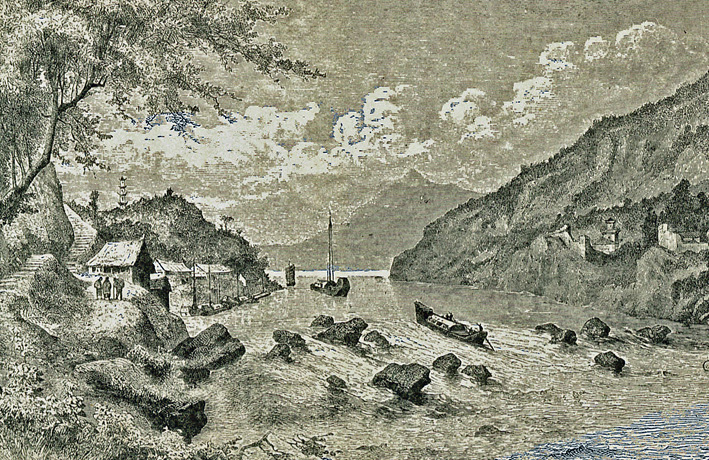|
Alexander Wylie's exploration of China and contributions to Western knowledge of China's literature and the Shu Roads |
|
|
|
Hazards and Rapids on the Upper Han River |
|
Introduction:
Alexander Wylie (1815-1887; Chinese name: Weilie Yali 伟烈 亚力) was a British Protestant Missionary who spent many years in China and was well-known for his Chinese language skill and scholarship. In addition to missionary texts, he wrote articles in Chinese containing “Useful Knowledge” such as mathematics, astronomy and engineering. He is also well-known for his collected biographies of Missionaries to China and (well before Joseph Needham) bringing to the attention of the west the advanced state of Chinese science and mathematics in the past. Wylie also edited a number of publications, translated ancient Chinese texts and contributed to modern Chinese studies with his articles in Chinese about many subjects. He followed in the earlier tradition of Charles Gutzlaff and Walter Henry Medhurst in his breadth of activity and contribution.
After China had been opened by the Opium Wars, Wylie was active in finding out as much as possible about the interior of China. After 1860, the Taiping rebellion had been extinguished and the most unequal of the “Unequal Treaties”, the “Treaty of Tien-tsin”, (Tienjin, 天津条约) had been signed in 1858 and was gradually coming into force. The Yangtze River was then open to traders, gunboats and missionaries. Hankou (汉口) in Hubei, where the Han River joined the Yangtze, became a centre of British interest. From there, shallow draft steamboats were eventually to move through the Yangtze gorges into Sichuan following the path of early explorations of Thomas Blakiston and others from Hankou to the meeting of the Yangtze with the Min River. Anticipating a commercial boom as China was opened, merchants were keen to know as much as possible about China’s interior and its access routes via whatever roads and rivers could be used to transport people and goods. It was in this environment that in 1868, Alexander Wylie and Griffith John made their adventurous journey beyond the current reach of steamboats on the Yangtze and on to Chengdu (成都) along the Min River. They then went by road north to Hanzhong (汉中) and back to the Yangtze at the Hankou settlement via the Han River (汉水) Valley. The way back to Hankou from Hanzhong was achieved mostly by boat on navigable sections of the Han River.
Wylie recorded the northern return journey from Chengdu to Hankou via Hanzhong in a learned paper presented to the Royal Geographical Society of London. The paper was well written, full of useful information for the time – and is still of use today. Of particular importance to the study of Shu Roads (蜀道), he travelled the Jinniu (Golden Ox, 金牛道) Road and a small part of the Northern Plank (北栈) road to reach Hanzhong from Chengdu. After that, he took some alternative linking paths overland and made use of navigable sections of the Han River to go past present day Ankang Xian (安康县 then (also) called Xing’an Fu, 興安府) and back to the British concession at Hankou. It is clear from reading his paper that an objective was to obtain revised and new information updating current maps and particularly about the river systems and that he had a keen interest in the river trade and traffic he came across. The earlier part of the visit, from Hankou to Chengdu was a massive document and included a complete itinerary with place and river names as Chinese characters. It was printed in a local English magazine published in Shanghai in 1868. Together, these papers represented a significant contribution to geographic knowledge of the western interior of China.
There are a number of documents at this web site describing the journey that Alexander Wylie took along the Shu Roads to Hanzhong as well as other materials relating to his wider travels and literary publications in the mid-1800’s. Links to the material as well as a brief description of their contents is provided in the Table below:
Shu Road Website material relevant to Alexander Wylie
|
|||||||||||||||||||||||||||||||||||||||
NOTE: If you wish to download one of the larger documents above, it is often better to right click on the link and use the “Save Target As…” option rather than opening it in a browser.
|
